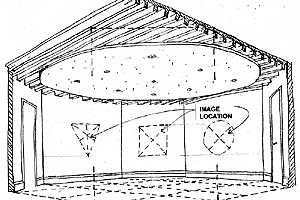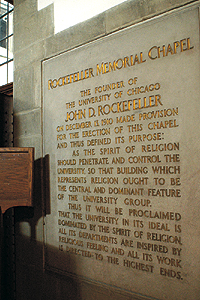Sanctuary for all of University’s faithful will open its doors for worship in April
By Jennifer CarnigNews Office
 Students and members of the administrative staff of Rockefeller Memorial Chapel, are eager for the new Interreligious Center in the basement of the chapel to open. Gathering in the chapel were second-year students (front row, seated) Tyler Zoanni and Sabahat Adil; Alison Boden, Dean of Rockefeller Memorial Chapel (left to right, second row), chapel staff members David Wyka and Lorraine Brochu, Eric VanLente (left to right, third row), a graduate student in Psychology, Alice Dan of the Buddhist Association and Laura Hollinger, Associate Dean of Rockefeller Chapel. | |
Chiseled in stone inside the front door of Rockefeller Memorial Chapel is a proclamation that the University in its ideal should be “dominated by the spirit of religion,” and the chapel is to be the home and foundation of that spirit. But religious life on campus has changed since the gothic chapel first opened its heavy doors in 1928. To meet the needs of a community becoming increasingly diverse and mirroring the religious complexion of the world, the underground floor of Rockefeller has been transformed from a basement into the new Interreligious Center.
The three-year, $1 million project—to be completed in time for a Tuesday, April 4 opening—will provide a home for all of the University’s faithful, from Christians to Jews, Hindus to Muslims and Baha’is to Buddhists.
“This is something that we’ve been thinking about and dreaming about for quite a long time, but after 9/11 we decided it was something that wasn’t just nice but also necessary for spiritual life on campus,” explained Alison Boden, Dean of Rockefeller Memorial Chapel and Senior Lecturer in the Divinity School and the College. “We wanted to support what is already good here on campus by giving students more of the support they need to sustain a healthy religious life.”
The new space provides a permanent place of prayer, worship and meditation for every member of the University’s religious community, and particularly those who have until now worshipped without a permanent space. Muslim students, for example, would need to carry their rugs with them throughout the day so they can pray. The only current designated prayer space has been a small office in the basement of the Reynolds Club that can hold four or five students at a time.
 | |
Similarly, Hindu students would have previously needed to transport bulky idols, statues and texts because they, too, were without a permanent place to worship.
That is why in the new center, Boden explained, two octagonal-shaped rooms were created and designated specifically for Muslim and Hindu use. A third, great room was created to serve as a fellowship or meeting space for up to 75 students, and two existing meeting rooms were upgraded to serve as additional meditation or study space.
Any of the University’s 35 religious groups may reserve the rooms, and all students, faculty and staff with valid I.D. cards will be able to use the space. This means that for any holiday or festival, night or day, year-round, students from all faith backgrounds will now have a place to worship.
“I think it’s psychologically important for students to know that their religion has a permanent home on campus,” said Lorraine Brochu, Director of External Affairs for Rockefeller. “And this truly helps Rockefeller live up to its mission. It’s not a Christian church but a worship space, and it should be used as such more than Sunday mornings at 11.”
To create the space, Boden organized meetings between members of the University’s religious student organizations and architect Nevin Hedlund, a noted designer of religious facilities. Representatives of the groups met with Hedlund at the same time for the series of design meetings.
“That was very intentional,” Boden said of the interfaith conversations, explaining that one of her hopes for the center is that by worshipping side-by-side, students will learn about the world’s religions and develop relationships with people from all backgrounds and faith systems.
 Rockefeller Memorial Chapel’s mission was written in stone when the building was erected in the late 1920s, opening its doors for the first time in 1928. Above in the center of the page, is an artist’s rendering of the prayer room in the new Interreligious Center in the lower level of the chapel. The new center will provide space for students of all faiths to practice their religions. | |
“The hope has always been that we will not just meet a need, but encourage a sharing of faith and a development of deep relationships, as well as an understanding of lived faith—one that you can’t glean just by reading a book,” she continued.
Sabahat Adil and Tyler Zoanni, both second-years in the College, already have developed such a friendship. Adil, a Muslim, and Zoanni, a Lutheran, met through the RSO Interfaith Dialogue and are both anxiously awaiting the opening of the Interreligious Center.
“My faith is a central part of who I am, how I understand my life and how I strive to lead it,” said Zoanni. “The same is true for many students at the University, and I think it’s safe to say that all of us involved with planning the opening of the interfaith space are committed to seeking mutual understanding and interaction.”
Adil points to the Interreligious Center’s unique octagonal-shaped rooms, open floor plan and eggshell-colored walls as points to praise.
“It’s not just a place for Muslims, Christians or Buddhists alone, but rather, its uniqueness stems from the meticulous attention the planners paid to creating the space, which encourages conversation with both one’s own religious community as well as with others’,” she said.
For Adil, a member of a religious group that until now has not had a permanent space, the creation of the center also is profound on a spiritual level. Her hope is that “Muslim students will be able to shift their focus from concentrating on where they gather to what their gatherings will be about.”
The Interreligious Center will open its doors for the first time at 7 p.m. Tuesday, April 4, when an opening ceremony that will include a ribbon cutting by Provost Richard Saller and a light reception. The entire community is welcome to attend. For more information on the opening ceremony or the Interreligious Center, call (773) 702-2100.
![[Chronicle]](/images/sidebar_header_oct06.gif)